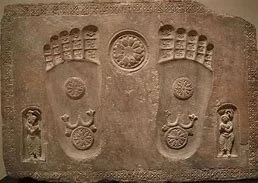JAPANESE ANCIENT HISTORY
Empress Kōmyō Jianzen Emperor Shōmu Buddha’s Footprints
The "official" introduction of Buddhism to Japan occurred in the middle of the sixth century. However, there were likely earlier contacts and attempts to introduce the religion by immigrants from the Korean Peninsula, as well as merchants and sailors who frequented the mainland that likely brought Buddhism with them, independent of the transmission as recorded in court chronicles.
Empress Kōmyō (701–760) established the Hidenin and Seyakuin in the Kōfuku-Temple in Nara, being two Buddhist institutions that provided free healthcare and medicine for the needy. For centuries to come Japanese Buddhist monks were essential in conveying Chinese medical know-how to Japan and in providing health care for both the elite and the general population.
In 753 A.D., the Chinese priest Jianzhen who was well-versed in medicine, arrived in Japan after five failed attempts in 12 years to cross the East China Sea. As he was blind, he used his sense of smell to identify herbs. He brought medical texts and a large collection of materia medica to the imperial palace in Nara, which he dedicated to the Emperor Shōmu in 756, 49 days after the emperor's death. They are kept in a log-cabin-style treasure house of the Tōdai-Temple (Tōdai-ji) known as Shōsōin.
It is reasonable to suppose that the knowledge of foot massage techniques were included. Japanese author Motoji Niwa found about 300 footprints of the Buddha in Japan. One of the stone carvings was found at the Kōfuku-Temple in Nara, Japan.



